CYLINDRICAL BILLIARD KNOT AND LINK, OR TURK'S HEAD KNOT
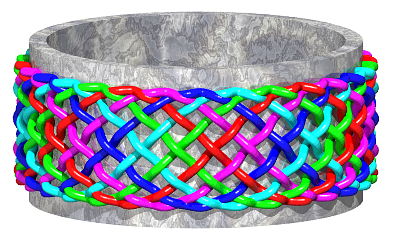
| next curve | previous curve | 2D curves | 3D curves | surfaces | fractals | polyhedra |
CYLINDRICAL BILLIARD KNOT AND LINK, OR TURK'S HEAD KNOT

| Links: Wikipedia
www.mi.sanu.ac.rs/vismath/pennock/index.html Images made by Alain Esculier. |
The cylindrical billiard knot, commonly called
"Turk's head knot", is the knot obtained
from a closed trajectory of a ball in a cylindrical billiard (we assume
that the ball is not subject to gravity!) by modifying the self-intersection
points and rather passing alternatively above and below an existing braid.
| We talk of a knot of type (q x p) or (p,q)
(p and
q are coprime) if the ball rebounds p times
on each edge and turns q times around the axis (knot experts call
them Turk's head knot with p bights, or braids,
and
q leads, or strands or even coils). Between two
rebounds, the curve self-intersects q – 1 times: therefore, there
are a total of p (q – 1) crossings.
Parametrization (portions of circular helices): NB 1: the English notation for the number q of
turns is L, initial of Lead and for the number p of rebounds,
it is B,
|
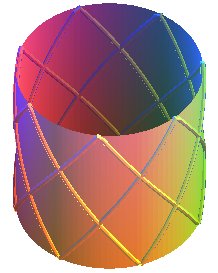
Here, p = 7 and q =3; 7 rebounds on each horizontal edge, 3-1 = 2 crossings on a trajectory between two edges. |
| The cylindrical billiard knot of type (q x p)
can also be obtained with cylindrical
sine waves.
Parametrization: |
 |
| With a conical projection on the tangent sphere, we get
a spherical sinusoid
: |
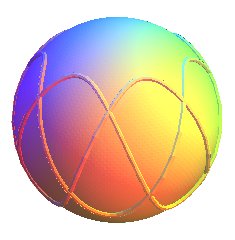 |
| With a conical projection on a plane perpendicular to
the axis, the cylindrical sine wave is flattened into a polygasteroid
with parametrization: if the initial version is projected, then the portions of circular helices are projected onto portions of reciprocal spirals: |
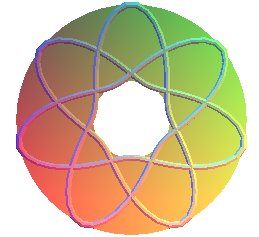 |
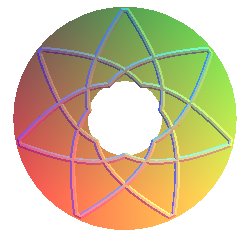 |
| With an inversion, the previous curves are transformed
into conchoids
of roses and portions of Archimedean
spirals:
Parametrization: |
 |
 |
| When p > 2q, but only in this case, the curve is topologically equivalent to the crossed polygon or polygram with Schläfli symbol {p/q} (p vertices, with every q-th point connected to one another). |
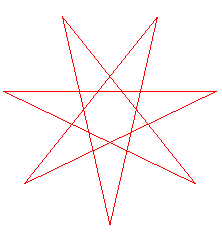 |
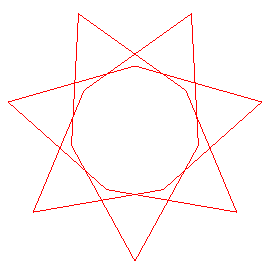 |
| On the left, in the case (3x4), passages above or below
were alternated.
But if, while going from one edge to the over, we always go above, and if, during the following passage between two edges, we always go below, then we get a toric knot, that differs from the alternated knot as soon as |
Examples (for q = 1, or 2, we refer the reader
to toric knots):
| p = 2 , q = 3: figure-eight knot |
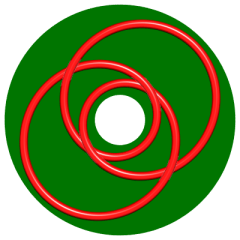 |
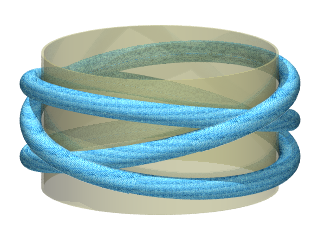 |
||
| p = 4, q = 3: knot 8.1.18 |
 |
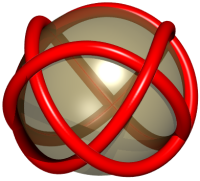 |
||
| p = 5, q = 3, knot 10.1.123 |
 |
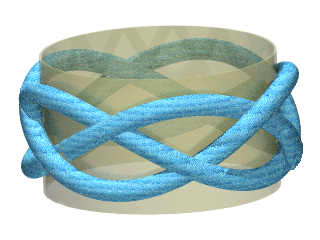 |
||
| p = 8, q = 3 |
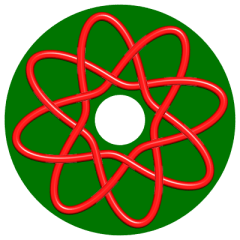 |
|
||
| p = 3, q = 4: knot 9.1.40 |
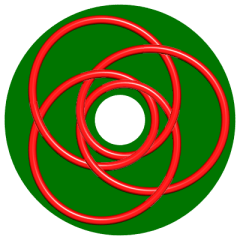 |
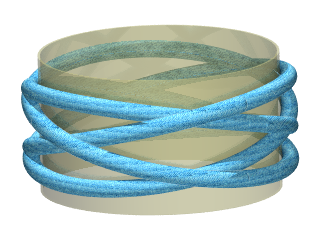 |
||
| p =5, q = 4: 15 crossings |
 |
|
||
| p =6, q = 5: 24 crossings |
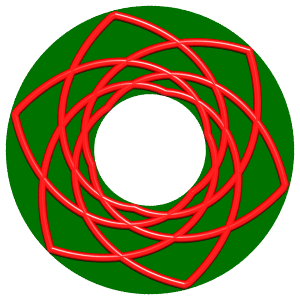 |
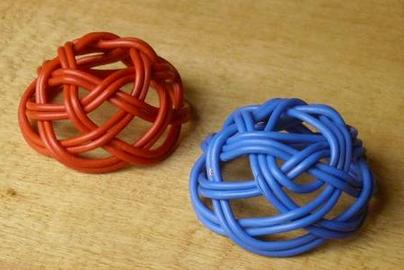 |
||
| p =5, q = 6: 25 crossings |
 |
|
||
| p = 11, q = 5 : 44 crossings |
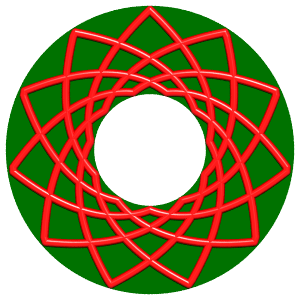 |
|
Nota: the case (n, n–1) is equivalent to the alternated generalized trefoil knot with n leaves.
Generalization to links.
Given p and q two non-coprime integers,
define d = gcd(p, q), p' = p/d, q' = q/d ;
the trajectory of a cylindrical billiard of type (q' x p')
and its d – 1 images by the rotations by
around the axis of the cylinder, with alternated above/below crossings,
form a link with
d components,
also called Turk's head of type (q x p).
There still are p (q – 1) crossings.
As we will see on the pictures, these links are very
popular in Islamic art.
For q = 1 or 2, the link is equivalent to the toric link of the same type.
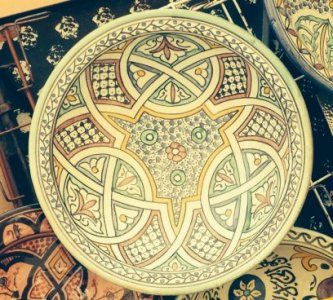 |
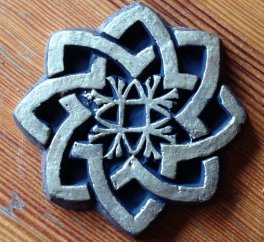 |
|
| Moroccan plate, type (2x6) (plus three loops) | Handmade Moroccan stucco, type (2x8), | Drawings of Eric Broug, specialist of Islamic patterns, type (2x12). |
Examples with :
| Roman mosaic of the
Villa
Romana del Casale, in Sicily: type (3x6); Brunnian
link.
Entangled in a (2x8). |
Bottom of a Turkish bottle: type (3x12); Brunnian link too. | Painted wood, Damascus: type (4x16) (picture Mohamed Roumi) | Logo of the European Society for Mathematics and Art:
type (8x12), non alternated. |
 |
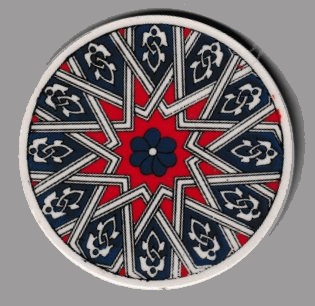 |
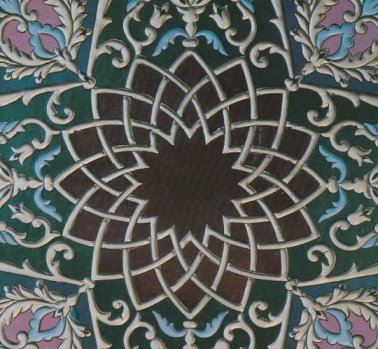 |
 |
Remark: if we authorize any type of crossings, and not
only alternating ones, then we get all the possible knots. Indeed,
every
knot has a projection that is a regular crossed polygon.
| See also the polygonal
knots, which are equivalent to Turk's heads.
Opposite the type (3x4) knot. |
 |
Compare to the rectangular
billiard knots.
|
See also the graph associated to the Turk's head of type (q x p) (which has p(q–1) edges), that enables an easy drawing of the knot. Opposite, the type (3x5) and (4x5) knots, and their graphs with 10 and 15 edges. |
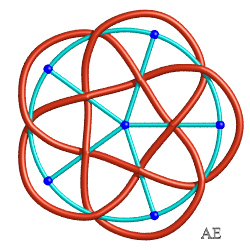 |
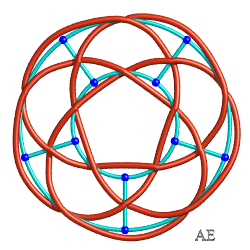 |
Buy Turk's head pendants: www.golden-knots.com/pendant.html
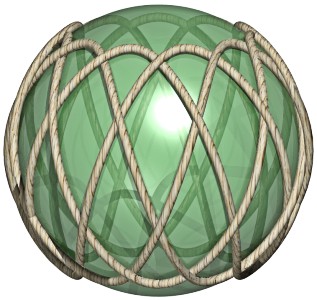

| next curve | previous curve | 2D curves | 3D curves | surfaces | fractals | polyhedra |
© Robert FERRÉOL 2018